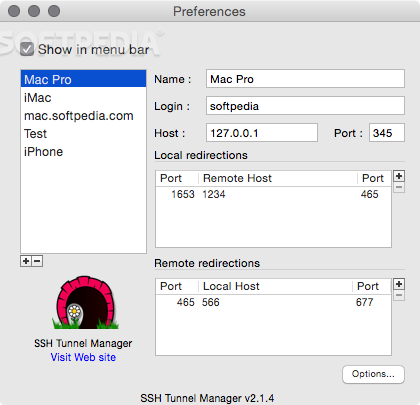
To start using it you need a config like this: # LocalPort TargetHost TargetPort SshHost SshUsername SshKeyPathġ8080 80 User D:\secure\path\to\private_key. That's why I come up with custom Powershell script, easy configurable, changeable, small, but works. If your session already exists, Load it as shown below: Step 2 Configure PuTTY for RDP In the Tunnels section in PuTTY, configure a specific Local port, such as. Enter your Saved Sessions name, and click Save. I tried many solutions like SSH tunnel managers, but all were inconvinient for me: too many configuration screens, sometimes buggy (one time SSH tunnel manager purged all! settings I had! So I had to restore settings for all 30 tunnels). In your PuTTY configuration, configure the Host Name and Port of your remote SSH computer.
#Ssh tunnel manager gui how to#
I did find this question: How to reliably keep an SSH tunnel open?, but that's using Linux as the SSH client, and I'm using Windows. Earlier SSH tunneling was used in Linux/Unix environment only, but today you can use it in Windows 10/Windows. SSH port forwarding allows you to tunnel (forward) app ports from a local computer to a remote server and vice versa.
#Ssh tunnel manager gui windows 10#
I'm planning on making a dedicated user with no privileges and not allowed to interactively log in, and use that.) In this article we will show how to use the built-in Windows 10 OpenSSH server to forward ports via an SSH tunnel. (Yes, I am aware of the hazards of automatically logging in to SSH. The two tunnels are one local tunnel, and one remote tunnel.

The data I'm sending across the two tunnels is VNC connections, so I often won't be at the machine to clear errors and enter passwords. What I'd like to do is have an application that can set up the two SSH tunnels, and can automatically reconnect, without needing to manually do anything, including enter a password. SSH tunneling, also known as SSH port forwarding, is how SSH tunnels network traffic through application ports from the localhost - the computer physically. This works well, except when the SSH connection drops: PuTTY displays an error message, and I need to manually close the error and reconnect to the server. Keep in mind these are arguments to the ssh commands, so they work in the context of a SSH connexion to a. If you dont know what SSH tunnels are, you can read more about them here or in the man page in the -L and -R sections.

 GUI SSH aws ssm start-session -target
GUI SSH aws ssm start-session -target Helper tools for AWS Systems Manager: ssm-session, ssm-ssh and ssm-tunnel. I'm trying to set up a Windows computer to always have two SSH tunnels to my Linux server.Ĭurrently, I'm using PuTTY to open the two SSH tunnels: I log in to the server in PuTTY, leave it minimized, and never touch it. SSH Tunnel Manager is a macOS application to manage SSH tunnels. Now go to same file location /.ssh/authorizedkeys and copy the key.


 0 kommentar(er)
0 kommentar(er)
